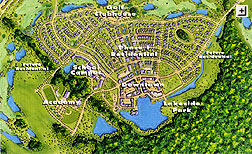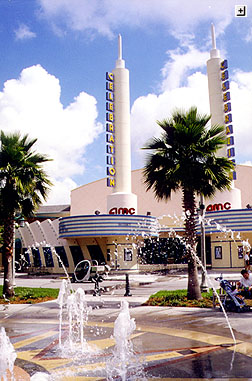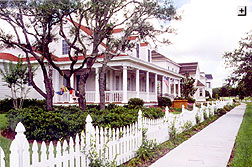
Office: HGH 210; phone: (408) 924-5378
Email: wooda@email.sjsu.edu
Web: http://www.sjsu.edu/faculty/wooda

|
Dr. Andrew Wood Office: HGH 210; phone: (408) 924-5378 Email: wooda@email.sjsu.edu Web: http://www.sjsu.edu/faculty/wooda |
 Celebration Village Site Plan - Copyright The Walt Disney Company
|
Celebration is an
experiment in New Urbanism, an architectural movement seeking to
design cities that are pedestrian friendly, coherently themed, and community
centered. Generally, this form of architecture is designed to appeal to
folks who are nostalgic for small town life Celebration is designed to resemble
a "typical'' southern small town built of the 1930s, yet amenities include
a fiber-optic network and intranet as well as a state-of-the-art hospital.
A videotape playing at the Celebration Preview Center promises a "new American
town of Fourth of July parades and school bake sales. . . spaghetti dinners
and fireflies in a jar." The ironic relationship of future and past is epitomized
by a promotional sign that reads "Imagine how great it would have been .
. . to live fifty years ago with all the neat gear you have today." This
site is an example of heterotopia - a space where opposing narratives
co-exist to manage tension. To review, some characteristics of heterotopia
are:
The irony of Celebration is its attempt to meld rhetorics of past and future - to enact progress in both directions. It is vastly different than the future-oriented EPCOT Center imagined by Walt Disney in the last 1960s. Hellman (1970) describes the original plans for Disney World to resemble a chain of pearls connected by an electric monorail: an amusement park, a prototype community for tomorrow, an industrial park, an entrance complex, and a "jet airport of the future" (p. 122). With its vast dome, EPCOT would represent the rhetorical triumph of human technology over nature. |
 Celebration Theater - Copyright 1999 Andrew Wood |
Moreover, as with
Edge Cities imagined by Joel Garreau,
Disney's future world would be more humane than traditional urban developments:
"in an interesting inversion of the usual process, industry is following
the people" (p. 126). [To learn more about EPCOT, visit this online handout
created by Ramon
Rodriguez.]
Rejecting the unidimensional path toward progress epitomized by the 1960s plans for EPCOT, Disney intends for Celebration to represent a rhetoric of public life according to five cornerstones: community, education, place, health, and technology. Community represents a sense of shared obligation among individual homeowners who freely merge public and private roles. Education illustrates a dimension that inspires intellectual contemplation of the town's philosophy and institutionalizes process through which that vision is shared without outsiders and the young. Place is the rhetorical intersection of individual behavior, utterance, and attitudes with formal built structures, such as the Celebration school, hospital, and "town hall." As with community, discussions of place in Celebration are almost invariably preceded with the phrase, "a sense of." Health is a positive integration of physical, mental, and spiritual attitudes designed to enact a particular lifestyle. Like education, health a physical component of the construction of this new town and a way in which the town is rhetorically themed through a rhetoric of "wellness." Technology can be defined as the ability of humans to manipulate their environment through artificial means. In Celebration, technology speaks to a long-term vision of progress that is necessary to the maintenance of Celebration. An advertising booklet entitled, "Isn't This Reason Enough for Celebration?" (The Celebration Company, 1997) notes that, "[I]t's like having your business on a nice, quiet street right off the information superhighway" (n.p.). |
 Celebration Housing - Copyright 1999 Andrew Wood |
Can Celebration work?
I ask this question every time I discuss this community with students. Since
my first visit in 1996, and my subsequent journeys to this new town, I've
struggled with that question, too. One can't help but scoff at the notion
of a corporation "building" public life as one might roll out a new brand
of tennis shoes or an animated feature. Still, I cannot help but be intrigued
by the powerful response to this query offered by Philip Morris:
Successful or not, Celebration represents an important trend in public life - the heterotopian desire to experience both/and rather than either/or. Fixed somewhere between the machine and the garden, technopolis and arcadia, Celebration says as much about contemporary society as it does about the ambitions of Disney. |
References
In no way does this page seek to represent the opinions of Walt Disney Company, San Jose State University, or any other institution or person. Any use of copyrighted images and text in this page is strictly for the purposes of academic inquiry, comment, and criticism and is protected by fair use provisions of applicable copyright laws.